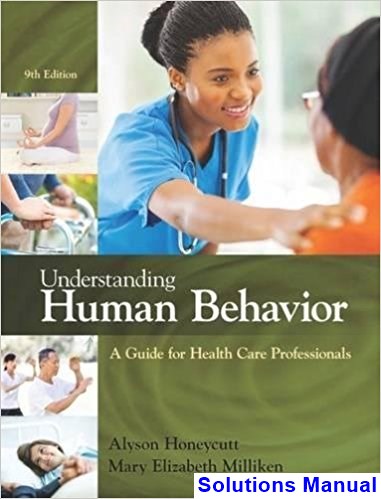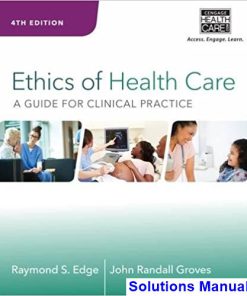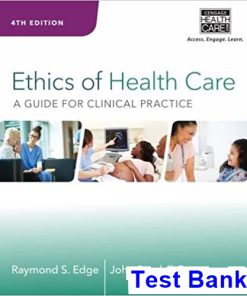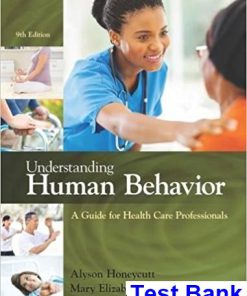Understanding Human Behavior A Guide for Health Care Professionals 9th Edition Honeycutt Solutions Manual
$26.50$50.00 (-47%)
Understanding Human Behavior A Guide for Health Care Professionals 9th Edition Honeycutt Solutions Manual.
You may also like
This is completed downloadable of Understanding Human Behavior A Guide for Health Care Professionals 9th Edition Honeycutt Solutions Manual

Product Details:
- ISBN-10 : 1305959884
- ISBN-13 : 978-1305959880
- Author:
Empowering you as a future health care professional, UNDERSTANDING HUMAN BEHAVIOR, 9e, delivers reliable, practical information that equips you with a solid understanding of basic psychological concepts from a health care perspective. Updated with the latest industry trends and examples, the text offers streamlined coverage that spans a broad but valuable range of important mental health topics — as well as their implications for you as a health care professional. It includes new coverage of cultural bias and cultural competence; developmental disorders; trauma-informed care; drug use in the U.S.; alternative, complementary, and integrative medicine; stress-management techniques; and much more. Presenting both client and caregiver perspectives, this powerful resource explores the behaviors, emotions, and coping mechanisms you may encounter in a variety of health care situations and settings. Practical examples and activities help you apply what you learn to real-world scenarios.
Table of Content:
- Section I: On Becoming a Health Care Professional
- Ch 1: Challenges and Responsibilities of Health Care Professionals
- Satisfactions
- Challenges
- Responsibilities
- Planning for Success
- Empowerment
- Making a Decision
- Ch 2: The Philosophy of Individual Worth
- The Meaning of Individual Worth
- The Health Care Professional and Cultural Bias
- Implications for Health Care Professionals
- Practicing a Philosophy of Individual Worth
- Ch 3: Self-Understanding
- Your Role as a Student
- Taking a New Look at Yourself
- Your Life Roles
- Section II: Understanding Human Behavior
- Ch 4: Influences on Behavior
- The Basis of Human Behavior
- How People are Alike and Different
- Heredity
- The Developmental Process
- Environment
- Influences during Childhood
- Changing Influences during Life
- Assuming Responsibility for Behavior
- The Health Care Professional and the Patient
- Ch 5: Physical Needs
- Maslow’s Hierarchy of Needs
- Essential Physical Needs
- The Sleep Cycle
- Satisfaction of Physical Needs
- Comfort and Safety Needs
- Physical Needs and Behavior
- Understanding Behavior in Terms of Physical Needs
- Ch 6: Self-Esteem and Social Needs
- Social/Emotional Needs
- The Self-Concept
- Self-Esteem
- Influence of others on One’s Sense of Self
- Effects of Success and Failure
- Success
- Finding Self-Approval
- The Importance of Acceptance
- The Importance of Approval from Others
- Conformity
- The Need to Believe That Others Care
- The Need for Appreciation
- Social/Emotional Needs and Behavior
- Behavior and the Health Care Professional
- Ch 7: Emotions and Behavior
- Meaning of Emotions
- Importance of Emotions
- Physiological Effects of Emotions
- Stress
- Positive Emotions
- Negative Emotions
- Formation of Emotional Patterns
- Individual Differences in Emotional Patterns
- Gender Differences in Emotions
- Using Emotions Constructively
- Emotions and Behavior
- Ch 8: Adjustment and Patterns of Behavior
- Good Adjustment
- Poor Adjustment
- Effective Behavior versus Ineffective Behavior
- Emotions and Adjustment
- Daily Hassles
- Improving Adjustment
- Section III: Behavior and Problems in Living
- Ch 9: Common Threats to Adjustment
- Change as a Threat to Adjustment
- Life Stages and Change
- Social and Cultural Stressors
- Major Changes
- Chronic Stressors
- Coping Skills and Resilience
- Ch 10: Effects of Trauma
- What is Trauma?
- Traumatic Experiences
- Domestic Violence
- Reactions to Trauma
- The Survivor Role
- Trauma-Informed Care
- Ch 11: Defense Mechanisms
- The Purpose of Defense Mechanisms
- Rationalization
- Projection
- Displacement
- Escape into Illness
- Repression
- Withdrawal
- Substance Abuse and Dependency
- Codependency
- Defense Mechanisms and Adjustment
- Ch 12: Frustration and Inner Conflict
- Degrees of Frustration
- Cumulative Effects of Frustration
- Sources of Frustration
- Effects of Frustration
- Frustration and Behavior Patterns
- Perfectionism and Frustration
- Coping with Frustration
- Inner Conflict
- Types of Inner Conflict
- How to Deal with Inner Conflict
- Inner Conflict and Adjustment
- Inner Conflict and the Health Care Professional
- Inner Conflict and the Patient
- Using Knowledge about Inner Conflict
- Section IV: Effective Human Relations and Communication
- Ch 13: Effects of Illness on Behavior
- Physical Effects of Illness
- Emotional Effects of Illness
- General Effects of Serious Illness
- Influences on Patients’ Reactions to Illness
- The Challenge for Health Care Professionals
- Ch 14: Human Relations and Coping with Patient Behavior
- Practicing Effective Patient Relations
- Helping Patients Adjust to Illness
- General Guidelines
- Common Behavior Patterns of Patients
- Conclusion
- Ch 15: Practicing Effective Communication
- Observing and Interpreting Nonverbal Behavior
- Verbal Communication
- Ambiguity
- Discrepancies in a Message
- Paraverbal Communication
- Effective Listening
- Assumptions and Expectations
- Improving Communication Skills
- Communication and the Health Care Professional
- Section V: Death and Loss
- Ch 16: Grief and Loss Throughout Life
- Learning to Cope with Change and Loss
- Significance of Loss
- Losses Due to Death
- Suicide
- Death of a Parent
- Losses in Specific Periods of the Life Span
- Guidelines for Using Loss and Grief as a Growth Experience
- Understanding Grief
- Effects of Grief
- Importance of the Grief Process
- Influences on the Grief Process
- Roles of Health Care Professionals
- Guidelines for Assisting the Family of a Dying Patient
- Ch 17: Death: Attitudes and Practices
- Past Attitudes and Practices
- Changing Attitudes and Practices
- Current Attitudes and Practices
- The Emergence of Thanatology
- The Meaning of Death
- Death with Dignity
- Euthanasia
- Evolution of the Right-to-Die Movement
- Societal Issues Related to Care of the Dying
- Legal Aspects of the Right to Die
- A Dilemma for Health Care Professionals
- Ch 18: Caring for the Dying Person
- Reactions to Diagnosis of a Terminal Illness
- Stages of Dying
- Dying as a Growth Process
- Personal and Family Issues Related to Care of the Dying
- Home Care
- Hospice Care
- Palliative Care
- Medical Issues Related to Care of the Dying
- Rights of the Dying Person
- Roles of Health Care Professionals
- Guidelines for Care of a Dying Person
- Section VI: Trends in Health Care
- Ch 19: Health Care through the Ages
- Healing in Early Civilizations
- Evolution of Modern Health Care
- Allopathic, Alternative, and Complementary Medicine
- Holistic Medicine
- Innovators and Modern Medicine
- Issues in Health Care
- Staying Informed
- The Health Care System-Today and Tomorrow
- Ch 20: What Is Healing? Who Is the Healer?
- The Immune System-Protector and Defender of the Body
- The Placebo Effect
- The Mind/Body Healing System
- Who Gets Sick? Who Gets Well?
- The Therapeutic Environment
- Intention
- Who Survives?
- The Holistic Approach to Health Care
- Conclusion
- Ch 21: Alternative, Complementary, and Integrative Medicine
- What Is Legitimate Therapy?
- Holistic Medicine
- Psychoneuroimmunology
- Osteopathy
- Chiropractic
- Naturopathy
- Psychotherapy/Counseling
- Homeopathy
- Ayurvedic Medicine
- Traditional Chinese Medicine
- Acupuncture
- Acupressure and Shiatsu
- Reflexology
- Therapeutic Massage
- Healing Touch
- The Self-Help Trend
- Integrative Medicine
- Role of the Health Care Professional
- Ch 22: Managing Stress
- Effects of Stress
- Managing Stress
- Relaxation
- Exercise
- Mindfulness
- Using Positive Affirmations
- Glossary
- Index
People Also Search:
understanding human behavior a guide for health care professionals
understanding human behavior a guide for health care professionals 9th edition honeycutt
understanding human behavior a guide for health care professionals honeycutt
understanding human behavior a guide for health care professionals 9th edition
understanding human behavior a guide for health care professionals download scribd
understanding human behavior a guide for health care professionals solution manual download pdf












